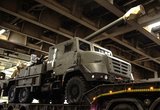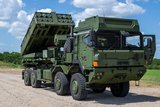Russian army plans new RC turret
The Russian MoD is investigating whether it can introduce a new remote-controlled gun turret for its airborne forces.
Tank manufacturer Uralvagonzavod, which has designed a turret module, is negotiating with the government to supply the system for the Russian Land Forces later this year.
The new turret has a 30mm 2A42 cannon, a 6P7K 7.62mm tank machine gun and provides for storage of 300 rounds of 30mm ammunition and 1,000 rounds of 7.62mm. It is also fitted with a TV/thermal imaging sight and laser range finder. It was displayed at the IDEX exhibition in February 2017.
According to Alexey
Already have an account? Log in
Want to keep reading this article?
More from Land Warfare
-
![Hungary set to begin using Hero 400 loitering munitions]()
Hungary set to begin using Hero 400 loitering munitions
Developed by Israel's Uvision and with systems being sold in the thousands to multiple European NATO countries and the US, the Hero family of loitering systems is also in production in the US and Italy, the latter through Rheinmetall.
-
![Lockheed Martin to look further afield for GMARS rocket system opportunities]()
Lockheed Martin to look further afield for GMARS rocket system opportunities
The HX truck is already in use in many NATO and allied countries around the world as a logistics vehicle and carrier for high-value systems, including missile firing weapons, so its use for the Global Mobile Artillery Rocket System makes logistical sense.
-
Medium knocked out of British Army LMP, with CAVS as heavyweight champion
As the British Army seeks to modernise and consolidate its diverse vehicle fleet, yet another change in direction is underway.























